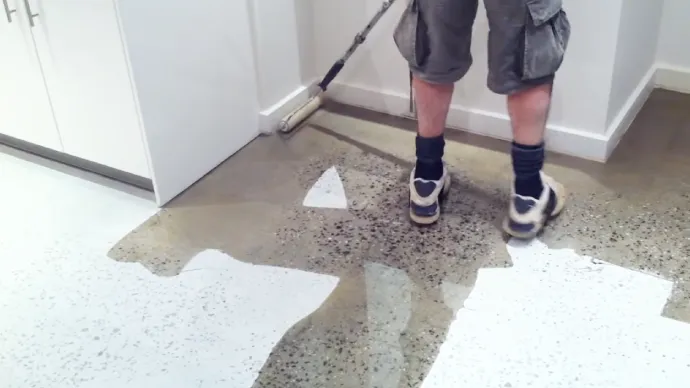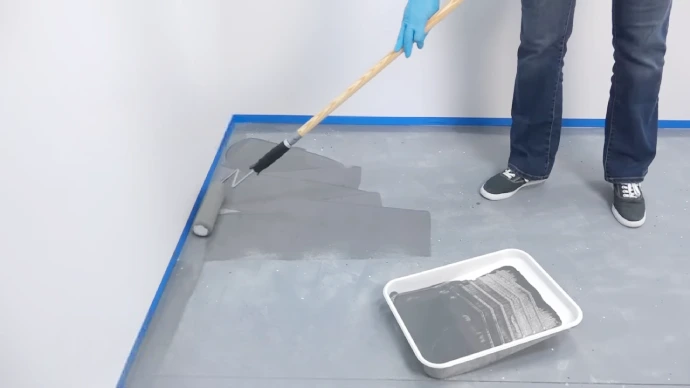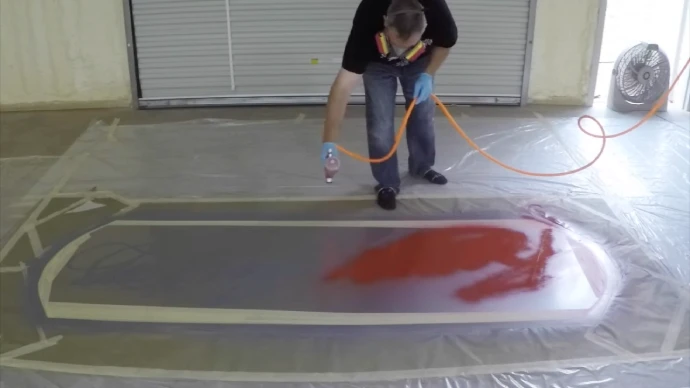Last Updated on January 11, 2023
Creating a beautiful and durable flooring solution can be a difficult task. Concrete floors are often used because they are affordable and long-lasting, but have their own set of challenges. Resurfacing sealed concrete with epoxy is an increasingly popular option, as it offers the durability of concrete coupled with the low-maintenance benefits of epoxy.
But how does this process work and is it right for you? In this blog post, we’ll discuss the basics of resurfacing sealed concrete with epoxy, including common questions like whether or not it’s possible to do so, if epoxy keeps the concrete from cracking, and how long you can expect your epoxy floor to last.
Pros of Using Epoxy on Sealed Concrete
Protection from Staining, Spills & Weather Conditions
The use of epoxy on sealed concrete surfaces provides superior protection from various types of stains, spills and weather conditions. An epoxy coating forms a protective barrier on the surface, which helps to prevent stains such as oil and grease from penetrating into the concrete.
It also helps to reduce weathering effects like fading or chalking due to UV exposure and prevents water seepage that can cause scaling or cracks in the concrete. Epoxy is also resistant to chemicals, which makes it an ideal choice for protecting outdoor surfaces that are exposed to corrosive elements such as saltwater or de-icing chemicals.
The use of an epoxy coating can also significantly reduce maintenance costs due to its ability to resist damage caused by these environmental factors.
Improved Appearance and Aesthetics
Epoxy coatings are available in a variety of colors and finishes that can be used to enhance the visual appeal of any sealed concrete surface. It can provide a vibrant color palette with hues ranging from subtle neutrals to bold statement colors.
It can also be used to create unique patterns and designs on the surface, giving it more personality and style. The glossy finish provided by epoxy gives sealed concrete a sleek modern look that adds interest and improve curb appeal.
Additionally, this type of coating is low maintenance and easy to clean, making it ideal for areas with heavy foot traffic or exposure to pollutants such as car exhaust fumes.
Increased Durability & Longevity
Using epoxy on sealed concrete provides increased durability and longevity when compared to other floor coatings such as paint or sealers. This is due in part because epoxy has excellent adhesion properties which allow it form strong bonds with the concrete surface that prevents peeling or flaking off over time due to wear and tear or chemical spills.
Additionally, since epoxy creates a waterproof barrier on the surface, it helps protect against water damage which can cause issues like cracking or staining at joints between slabs on floors with raised edges over time.
Finally, since epoxy is highly scratch-resistant it helps keep surfaces looking new even after years of heavy use without having to perform costly repairs or replacements each year like you would with other floor coatings solutions.
Cons of Using Epoxy on Sealed Concrete
Limited Choices in Color & Design Options
One of the major drawbacks of using epoxy on sealed concrete is that there are limited options in terms of color and design. Epoxy is a highly specialized material, and it has a limited range of colors available for use on sealed concrete surfaces.
This can be an issue if you’re looking for a specific color or pattern to match your existing décor, as the choices are simply not available with epoxy. Additionally, epoxy does not offer much creativity when it comes to design possibilities while other flooring materials such as tile or carpet allow you to create intricate designs with different colors and shapes, epoxy is fairly limited in its design offerings.
Thus, if you’re looking for something more unique or creative than what epoxy provides, then it may not be the best option for your application.
Costly Installation and Maintenance Processes
Another con of using epoxy on sealed concrete is that the installation and maintenance processes can be quite costly. Installing an epoxy coating on a sealed concrete surface requires professional expertise, as it has to be applied correctly in order for it to look good and last longer than expected.
As such, hiring experienced professionals who know how to properly apply epoxy coatings will likely rack up quite a bill over time – this cost can be further compounded by additional expenses related to maintenance such as resealing the surface every few years or repairing any damage that occurs due to wear and tear over time.
Moreover, the cost of purchasing the actual materials needed for installation can add up quickly as well, making it one of the more expensive flooring options out there when taking into account both labor costs and materials costs associated with installation and maintenance processes over time.
Risk of Damage Due to Poor or Improper Application
Finally, another con that comes along with using epoxy on sealed concrete surfaces is the risk of damage due to poor or improper application techniques during installation or repair projects.
Since this type of flooring material must be applied correctly in order for it to look good and last long-term, any mistakes during its application can lead to long-term damage that will require costly repairs down the line these repairs may also involve completely replacing sections of damaged epoxy if they cannot be salvaged through regular maintenance practices like resealing them periodically or applying appropriate repair kits when necessary.
All these potential risks should be taken into consideration prior to deciding whether an epoxy coating is right for your project’s needs given all these potential issues that come along with using this type of material, you may want to consider alternative flooring options like tile or carpet instead!
Preparing Sealed Concrete for Epoxy Coating: Steps Involved

Removal of Existing Sealants & Coatings:
When preparing sealed concrete for epoxy coating, the first step is to properly remove any existing sealants and coatings from the surface. This can be done manually by scraping off with a plastic scraper or putty knife, or by using chemical agents such as paint strippers or solvents.
It is important to ensure that all existing sealants and coatings are completely removed to ensure proper adhesion of the new epoxy coating. If any residue remains on the surface, it may prevent proper adhesion and create bubbles in the new coating.
After all sealants and coatings have been removed, it is important to clean the surface thoroughly before applying primer and epoxy coating.
Stripping Old Paint, Stains & Grime Buildup:
The next step in preparing sealed concrete for epoxy coating is to strip away any old paint, stains, and grime buildup from the surface. This can be done with chemical agents such as paint strippers or solvents, or by using mechanical methods such as sandblasting or high-pressure water jetting.
When using chemical agents to strip away paint, care must be taken not to damage the underlying concrete substrate with overuse of these chemicals. Additionally, once all old paints, stains and grime have been removed from the surface it is also important to rinse off any residue remaining on the concrete with a pressure washer before beginning work on priming and coating.
Cleaning and Prepping the Surface for Proper Adhesion:
Before applying primer and epoxy coating to sealed concrete surfaces it is necessary to properly clean and prepare them for maximum adhesion of these products. Cleaning should involve removing any dirt, dust and debris from the surface with a broom or vacuum cleaner before wiping down with a damp cloth containing a mild detergent solution.
For best results it is advisable to wash down walls twice —once with plain water followed by another wash down with a mild detergent solution—and then allow them to dry thoroughly before proceeding further. Once prepped correctly it will ensure maximum adhesion of both primer and epoxy coating when applied later on in this preparation process.
Patching Cracks And Holes With Repair Products:
If there are any cracks or holes present in sealed concrete surfaces they will need filling prior to applying primer or epoxy coatings onto them. This can be achieved via various repair products available in most hardware stores such as patching compounds specifically designed for use on concrete as well as other materials like wood fillers that can also work well in some cases depending upon requirements.
To fill holes or cracks effectively each product should be applied according to directions given on packaging before allowing sufficient time for drying before proceeding further into this preparation process for an epoxy coated finish..
Sanding Roughening Or Etching The Surface For Stronger Bonding:
Once repairing cracks/holes is complete it is advisable that rough surfaces should be created via sanding roughening or etching techniques prior to applying primer/epoxies onto sealed surfaces for better bonding properties of these products when cured/hardened over time after application has finished successfully at this stage of preparation process for an epoxy finish result.
Sandpaper can provide good results when used depending upon size/grain type chosen whilst etching techniques require stronger acid solutions that must always be handled safely & responsibly when undertaking these operations due their hazardous nature if not observed cautiously throughout duration of project being undertaken at this stage .
Applying Primer For Maximum Coating Adhesion And Performance:
The last step before actually applying an epoxy coating onto sealed concrete surfaces involves applying an appropriate primer suitable for given job requirements at hand so maximum performance/adhesion properties are achieved when cured over time after application has successfully been completed.
Generally speaking most manufacturer instructions will recommend using specific primers suitable only per product being used hence why consulting relevant documentation prior starting work shall ensure correct choice has been made ensuring all desired performance criteria are met even after prolonged periods post-application .
Can you epoxy over sealed concrete?

Yes, you can epoxy over sealed concrete. Epoxy is a type of material used to coat and seal surfaces like concrete. It creates a strong bond between the surface and the coating, making it more resistant to wear and tear. The epoxy will also help protect the underlying concrete from moisture, dirt, and other substances that could cause damage.
Does concrete sealer wear off?
It depends on the type of sealer used and how it was applied. Some types of sealers are designed to be permanent, while others may require touch-ups or reapplication every few years to maintain their effectiveness.
In general, acrylic sealers tend to hold up better than other types, while solvent-based sealers typically require more frequent maintenance. When properly applied and maintained, most sealers should last anywhere from 5-10 years before needing significant repair or replacement.
How long does epoxy over concrete last?
Epoxy coatings can last for many years when properly applied and maintained. They are highly durable and resistant to wear and tear, as well as water damage.
The lifespan of an epoxy coating will depend on the quality of the coating itself as well as how often it is exposed to moisture or other environmental elements such as ultraviolet (UV) rays from the sun. Generally speaking, high-quality epoxies should last for about 10 years before needing any maintenance or repair work done.
Does epoxy keep concrete from cracking?
Epoxy coatings can help reduce cracking in concrete by providing an extra layer of protection against moisture intrusion that could otherwise lead to cracks in the surface of the concrete slab or foundation wall over time.
Additionally, some types of epoxies contain additives that make them flexible so they move with the substrate instead of cracking when subjected to thermal expansion or contraction due to changing temperatures throughout the year in different climates.
Conclusion:
When it comes to resurfacing sealed concrete with epoxy, there are several things to consider before proceeding. It is important to make sure that any surface sealant has been completely removed before beginning the application process.
Additionally, properly installing and maintaining your new epoxy floor will help ensure that it lasts as long as possible without cracking or warping due to environmental conditions. With careful preparation and maintenance, your epoxy over sealed concrete flooring should last for many years while providing you with a beautiful and durable surface that stands up against everyday wear and tear.



